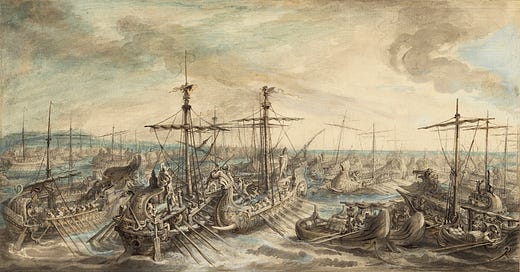The First Punic War: A Military History
How Rome and Carthage clashed for control over the Western Mediterranean.
The Punic Wars were a cataclysmic clash between Rome and Carthage. The word “Punic” comes from the Latin word Punicus, meaning “Phoenician.” It is a reference to the Phoenician ancestry of Carthage. Initially, Carthage enjoyed good relations with Rome. As the two became the dominant powers of the Western Mediterranean, conflict became inevitable.
The first of the three Punic Wars is not well understood. There aren’t many contemporary sources. Polybius wrote about it, but he lived over 40 years later. It was a naval war, rather than a land one. The first war is often just regarded as a precursor to the more important Second Punic War.
To set the stage, Rome was rapidly expanding in the 3rd century BC. This led to conflicts between Rome against the Greek colonies of southern Italy. In 280 BC, the city of Tarentum hired King Pyrrhus of Epiros, a Greek mercenary, for protection against the Romans. Despite his victories at Heracles and Asculum, King Pyrrhus was not unable to decisively defeat the Romans. He decided to leave Sicily for another mission: to protect Syracuse from Carthage. In late 276 BC, Pyrrhus returned to Sicily, but he was defeated by the Romans at the Battle of Beneventum. By 272 BC, the Romans had successfully annexed all of southern Italy.
Carthage, too, was a booming expansionist power. It was founded as a colony of the Tyre-based Phoenician people back in 814 BC. For centuries, the Phoenician traders exported their mercantile goods across the Mediterranean world, establishing colonies along the way. Carthage, like the other Punic colonies, made its fortunes from the international sale of ivory, gold, and slaves.
By the 3rd century BC, Carthage had grown into a strong regional power. Carthage had shunned absolute rulers in favor of republicanism. They elected their rulers, and had a Senate and aristocracy. Power came from wealth, not nobility. Wealth came from Carthage’s vast network of overseas trade. Bit by bit, Carthage expanded its mercantile influence across North Africa and the Mediterranean, establishing prosperous colonies in Iberia, Sicily, Sardinia, and Corsica. Meanwhile, the various Italic peoples were being united under a single Roman state.
At first, Rome and Carthage enjoyed amicable relations. They opened up mutually beneficial trade routes to one another. But their good relations were threatened when, in 264 BC, the city-state of Messana approached both Rome and Carthage for protection. The dispute involved the western coast of the island of Sicily, which was a province of Carthage, which was disputed between the rival city-states of Messana and Syracuse. The Punic forces arrived first, but were criticized by the Romans. When Messana sided with Rome, however, Carthage responded by placing Messana and its rival, Syracuse, both under siege. The First Punic War had begun.
The Romans were excellent strategists. Over the next 20 years, Rome would rebuild its entire fleet to confront Carthage’s powerful navy. They began by luring Syracuse into a confrontation. When they took the bait, the Romans crushed them, and proceeded to confront the besieging Punic troops. After hiring mercenaries to replace their allies in Syracuse, Carthage moved their regular forces to Akragas. The Romans chased them there, laying siege and trapping them. Carthage responded by summoning their mercenaries to relieve the Roman siege. Rome scored its first sea victory at the Battle of Mylae in 260 BC.
The war in Sicily dragged on into a stalemate. As the Romans consolidated control over the island, the Punic forces resisted with guerrilla warfare. The Romans responded by challenging Carthage on all fronts. Coping Carthage’s masterfully designed ships, the Romans set out to build a strong navy to undermine Punic hegemony at sea. The Romans, in a master feat of engineering, designed ships to latch onto the Punic naval forces. This transformed a naval war into a land one, which the Romans had long mastered.
The Romans briefly captured Corsica, but were kicked out of Sardinia. Exploiting their naval victories, the Romans invaded North Africa. Carthage was again defeated at the Battle of Cape Ecnomus, considered the largest naval battle in history. Rome’s invasion was successful, and Carthage sued for peace in 255 BC. But the terms of surrender were so harsh, that Carthage continued to fight. The Romans landed in Tunisia, where they were unexpectedly fought by Spartans. The Romans got bogged down by various skirmishes around North Africa, resulting in stalemate. Carthage ruled the sea, while Rome controlled Sicily. The Romans imposed a successful blockade against the Carthaginians at the Battle of the Aegates Islands in 241 BC, forcing the Punic troops at Sicily to surrender.
Under the Treaty of Lutatius, Carthage was forced to evacuate Sicily. All Roman prisoners of war were returned. Carthage was not allowed to make war from Syracuse. The Romans also imposed harsh war reparations, measured in talents of silver, over the next two decades. Exploiting Carthage’s weakness, the Romans were able to gain Sardinia and Corsica in addition to Sicily.
There were several reasons why the Romans were able to prevail against Carthage. Unlike Carthage, the Romans warmly awarded their consuls’ victories on the battlefield. In Carthage, failed generals were punished harshly by crucifixion, so they were much more cautious and restrained than their Roman counterparts. The Romans were better engineers, and they were excellent at copying their enemies’ tactics.
The First Punic War was a staggering, unexpected victory for Rome. The Romans, only a modest regional power, had managed to quickly learn naval warfare and subdue Carthage, the Mediterranean’s most formidable maritime empire.





